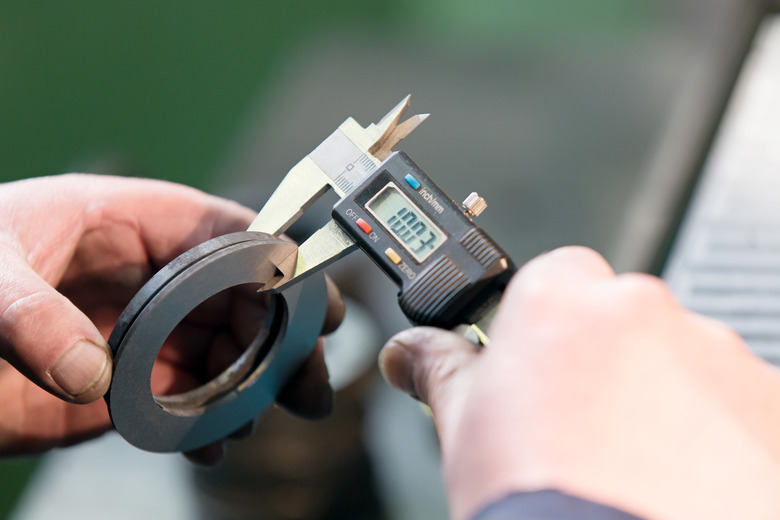How To Graph Fractions
You can graph a fraction in three different ways. The first is if you need to find out where a fraction exists on a number line; the second is if you're graphing coordinates that have fractional values. If you've ever read a ruler, you already have an intuitive grasp of the concepts you'll need for those two missions. The third option is when you're using slope, which is usually expressed as a fraction, to draw the graph of a line. If you've already mastered basic graphing, you already know everything you need for that particular challenge.
Graphing Fractions on a Number Line
Graphing Fractions on a Number Line
Graphing or drawing fractions in the right place on a number line is a lot like reading a ruler – except that you have to draw the ruler yourself.
1. Reduce the Fraction to Lowest Terms
Reduce the fraction to lowest terms by canceling common factors from the numerator and denominator. For example, if you've been asked to graph 10/15 on a number line, you could factor 5 out of both the numerator and denominator, leaving yourself with 2/3.
TL;DR (Too Long; Didn't Read)
You can write the fraction in any form you want, but reducing it to lowest terms will save you a lot of labor when it comes to drawing the number line.
2. Locate and Mark the Nearest Integers
Locate the integers that would be to either side of the fraction on the number line. In this case, the next whole number larger than 2/3 is 1, and the next smaller number is 0. Mark those numbers on the number line, leaving enough room for several subdivisions between them.
3. Subdivide Between the Numbers
Note the denominator of your fraction; continuing the example, the denominator is 3. Mark that many subdivisions between the integers from Step 2. So in this case, you'd mark out three subdivisions between 0 and 1.
4. Count and Mark
Count out the subdivisions, starting from the lower integer you mapped out and moving toward the larger number. Stop when you've counted as many subdivisions as the numerator of the fraction. So in this case, because the fraction is 2/3, you'd stop after counting two of the three subdivisions. The place you stopped is where you place a mark for the fraction; make sure you remember to label it.
TL;DR (Too Long; Didn't Read)
Counting the number of subdivisions in your number line is just like counting the subdivisions on a ruler.
Graphic Coordinates That Involve Fractions
Graphic Coordinates That Involve Fractions
A two-dimensional graph is just a pair of number lines set perpendicular to each other, so much of what you learned in the previous example can be put to work for graphing in two dimensions, too.
1. Reduce the Fraction to Lowest Terms
Reduce any fractional parts of the coordinate set(s) to lowest terms if this hasn't been done already. In this case, imagine that you've been asked to graph the coordinate set (2, 3/7). The fraction is already in lowest terms, so continue to the next step.
2. Determine Your Scale
Note the number in the denominator of the fraction. Once again, this is the number of subdivisions you should make between integers. But this time, you must also look at the other coordinates you're being asked to graph.
If there are fractions with other denominators, you'll need to either approximate their placement or find a common denominator between all the fractions involved. Also, the scale of each axis must be large enough that even the most extreme values from your set of coordinates will still appear on the graph.
3. Label Your Axes
Label each axis with its units of measure (if appropriate) and then label along the axes to show their scale, just as you would with any number line.
4. Plot Your Points
Plot your points in the graph, using the same "count and mark" method laid out in the previous example to precisely place the fractional values.
Graphing a Line Using Fractional Slope
Graphing a Line Using Fractional Slope
If you're an algebra student learning to graph lines, you've probably already run into the concept of slope. Simply put, slope tells you how steeply a line tilts up or down. It's often expressed as a fraction, with the numerator showing the change in the y coordinate and the denominator showing the change in the x coordinate.
1. Locate a Point on the Line
In order for the slope of the line to be useful, you must also know the coordinates for at least one point on the line. Whatever those coordinates are, graph them.
2. Count Up
Starting from the point that you just graphed, count up the number units that are in the numerator of the fraction that represents your slope. So if the fraction is 4/5, you'd count up four units. (If the fraction were -4/5, you'd count down four units.)
3. Count Across
Starting from where you ended up in Step 2, count across the same number of units that are in the denominator of your slope. Continuing the example, if the fraction is 4/5, you'd count 5 units in the positive (rightward) direction. If the slope were 4/(-5), you'd count 5 units in the negative (leftward) direction.
4. Mark Your Point
The point you've just arrived at is on your line; mark it. You can continue as necessary to graph more points on the line, starting the process over from the last marked point every time.
Cite This Article
MLA
Maloney, Lisa. "How To Graph Fractions" sciencing.com, https://www.sciencing.com/graph-fractions-8404745/. 22 May 2018.
APA
Maloney, Lisa. (2018, May 22). How To Graph Fractions. sciencing.com. Retrieved from https://www.sciencing.com/graph-fractions-8404745/
Chicago
Maloney, Lisa. How To Graph Fractions last modified March 24, 2022. https://www.sciencing.com/graph-fractions-8404745/
